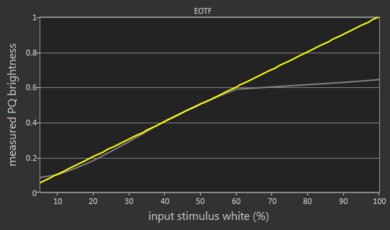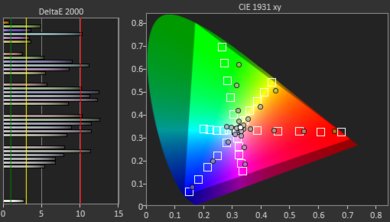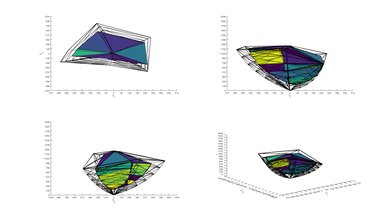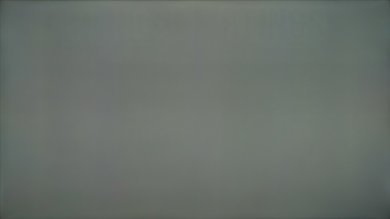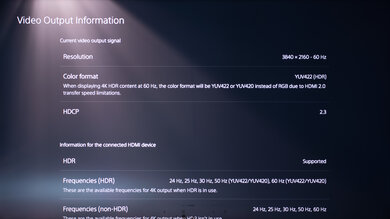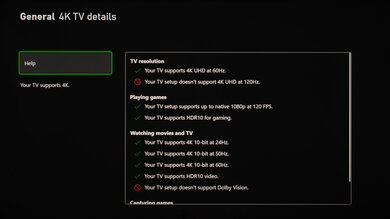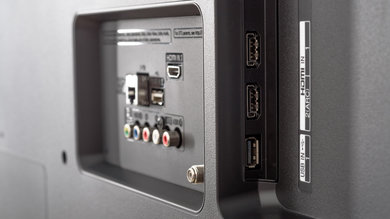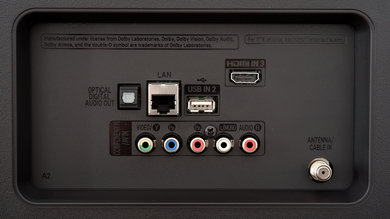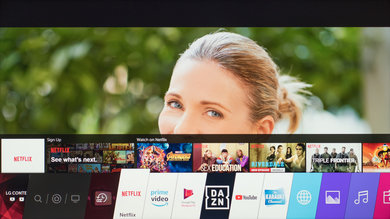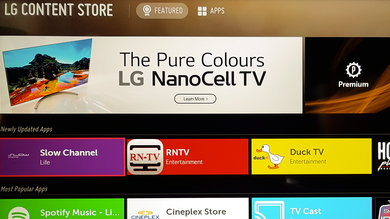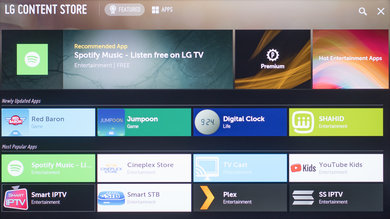Our Verdict
The LG UM7300PUA is a good TV for most uses. It's better suited for bright rooms, as its contrast ratio is mediocre and blacks tend to look like gray in the dark. It has exceptionally low input lag and response time to make it a great choice for gaming, and it has very little uniformity issues that can be distracting when watching sports. It can display HDR content, but performance is limited by its peak brightness and lack of wide color gamut support.
- Outstanding low input lag.
- Image remains accurate when viewed at an angle.
- Can't produce deep, uniform blacks.
- HDR doesn't add much.
Mediocre TV for watching movies in a dark room. It can't produce deep, uniform blacks. Motion looks decent overall, as it has an excellent response time, but there are duplications in motion from the backlight flicker. It can remove judder from true 24p sources, but not from movies played from a 60Hz source, like a cable box.
Great TV for watching TV shows during the day. It has decent peak brightness with SDR content and has excellent reflection handling, so you shouldn't have any issues in a decently-lit room. The image remains accurate when viewed at an angle. It has a great selection of apps, and most streaming channels are available.
This is a very good TV for watching most sports. It has wide viewing angles and excellent reflection handling, good for watching the big game with a group of friends. It has a fast response time, so there isn't much blur behind fast-moving objects, but there can be noticeable duplications in motion, which might bother some people.
The LG UM7300 is a great TV for playing video games. It has an outstanding input lag at all supported resolutions, and its response time is equally exceptional, with very minimal blur in fast-moving scenes. Unfortunately, it doesn't support any variable refresh rate technology, but it does have an 'Auto Low Latency Mode', which saves you the trouble of having to switch picture mode every time you want to play.
The LG UM7300PUA is mediocre for watching HDR movies. The TV supports HDR10, but not HDR10+ or Dolby Vision. Additionally, it can't display a wide color gamut and it can't get bright enough to bring out small specular highlights.
This is a good TV for HDR gaming, mainly due to the gaming performance, as HDR doesn't add much on this TV. It has outstanding low input lag, and an excellent response time. Unfortunately, it isn't as well-suited for late-night gaming, but the wide viewing angles make it a great choice for couch co-op gaming with some friends.
Excellent TV for use as a PC monitor. It has outstanding low input lag, for a responsive desktop experience, and it supports all of the common 60Hz resolutions. It has a great response time, but the backlight flickers at 120Hz, which can bother some people with prolonged use. It can display proper chroma 4:4:4, so text looks good in any resolution.
Changelog
- Updated Mar 09, 2021: Converted to Test Bench 1.6.
- Updated May 21, 2020: Converted to Test Bench 1.5.
- Updated Feb 21, 2020: Converted to Test Bench 1.4.
- Updated May 27, 2019: Review published.
Check Price
Differences Between Sizes And Variants
We tested the 55" LG UM7300 (55UM7300). For the most part, we expect our review to be valid for the 43" model (43UM7300), 49" model (49UM7300), and the 65" (65UM7300) model.
There is a 50" variant with a VA panel. We expect this model to have a much better native contrast and black uniformity, but the viewing angle won't be as good.
Update 01/29/2020: LG Canada has confirmed that the 49" model uses an RGBW panel, similar to the UM6900 we've tested.
| Size | US | Canada | UK | Panel Type |
| 43" | 43UM7300PUA | 43UM7300AUE | 43UM7390PLC | IPS |
| 49" | 49UM7300PUA | 49UM7300AUE | 49UM7390PLC | IPS, RGBW |
| 50" | 50UM7300PUA | 50UM7300AUE | N/A | VA |
| 55" | 55UM7300PUA | 55UM7300AUE | N/A | IPS |
| 65" | 65UM7300PUA | 65UM7300AUE | N/A | IPS |
If someone comes across a different type of panel or if their LG UM7300 doesn't correspond to our review, let us know and we will update the review.
The 55UM7300 we reviewed was manufactured in March 2019.
Popular TV Comparisons
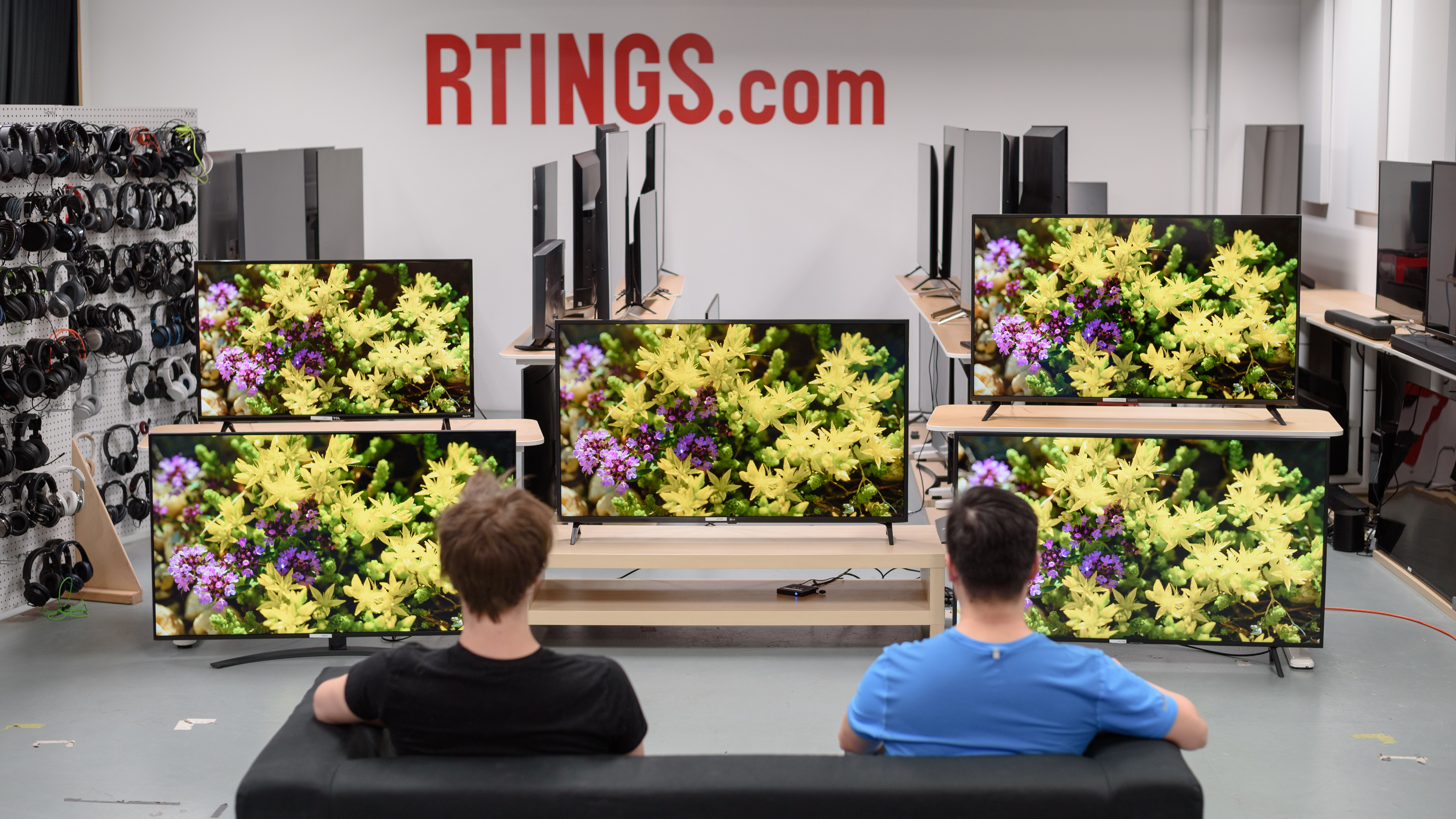
The LG UM7300 is a good TV for most uses. It is considered a budget entry-level TV, which is why a lot of high-end features such as support for variable refresh rate and local dimming are noticeably missing. Compared to other IPS TVs, it performs well, but its viewing angles aren't as good. For other options, see our recommendations for the best TVs, the best smart TVs, and the best 4k TVs.
The Samsung NU7100 and the LG UM7300 use different panels, and the best one depends on your usage. The NU7100 is better-suited for dark-room viewing, sitting directly in front. The LG UM7300 is better suited for watching with the lights on and is a better choice for a wide seating area. The UM7300 has better motion handling overall, with a much faster response time, which is better for gaming or other 60p content.
The LG UM7300 and the Samsung NU6900 has different panel technologies, each with advantages and disadvantages. The NU6900 can deliver deep blacks in a dark room thanks to its high native contrast ratio, whereas the UM7300 is a better choice if your room has a wide seating arrangement. Also, the LG can handle reflections better and can remover judder in most cases, whereas the Samsung can't remove judder at all.
The LG UM7300 is much better than the LG UM6900. The UM7300 is much brighter, has better black uniformity, and better reflection handling. The UM7300 uses an RGB IPS panel, whereas the UM6900 uses a less-accurate RGBW pixel structure. The UM7300 also comes with a more advanced remote and has voice control capabilities.
The LG SM8600 is a little better than the LG UM7300. The SM8600 has a faster response time, which is great for sports, and a wide color gamut, which is great for HDR. The UM7300 can get brighter, which is great for watching TV in a brighter room, and its Automatic Brightness Limiter doesn't change the brightness according to the scene.

We buy and test dozens of TVs yearly, taking an objective, data-driven approach to deliver results you can trust. Our testing process is complex, with hundreds of individual tests that take over a week to complete. Most of our tests are done with specially designed test patterns that mimic real content, but we also use the same sources you have at home to ensure our results match the real-world experience. We use two main tools for our testing: a Colorimetry Research CR-100 colorimeter and a CR-250 spectroradiometer.
Test Results
The back of the TV is very plain. Some of the connectors face directly out the back and may be difficult to access if wall-mounted. There's no integrated cable management.
The LG UM7300PUA is slightly thicker than the UK6300. It sticks out quite a bit when wall-mounted, especially if you use the back-facing inputs.
The LG UM7300 has a mediocre contrast ratio, which is expected of most IPS panels. Blacks will appear grayish when viewed in the dark, and unfortunately, there's no local dimming feature to improve dark room performance.
The 50" model is expected to have a VA panel, and will have a much better contrast ratio.
The 55UM7300PUA has a decent peak brightness, good enough for most decently-lit rooms, and there's very little variation in brightness when displaying different content.
Peak brightness was measured with the 'ISF Expert (Dark Room)' Picture Mode, which is the most accurate. Different picture modes and color temperatures can produce slightly different results.
If image accuracy isn't as important to you, the 'Vivid' Picture Mode delivers a slightly brighter image, reaching a peak of 402 cd/m² with a 10% window.
This TV doesn't have a local dimming feature. The above video is for reference only.
Mediocre HDR peak brightness, too dim to show off small specular highlights in some scenes. It's slightly brighter than the UK6300 and UK7700.
We measured the HDR peak brightness with the 'Cinema' Picture Mode before calibrating. Different picture modes and color temperatures can produce slightly different results.
If image accuracy isn't as important to you, the 'Vivid' Picture Mode delivers a slightly brighter image, reaching a peak of about 410 cd/m² with a 10% window.
Decent black uniformity, but there is noticeable backlight bleed, which is typical for IPS TVs.
The 50" model is expected to have a VA panel and will have a much better contrast ratio, and likely has better black uniformity.
The LG UM7300PUA has a decent viewing angle, but it isn't as good as most IPS TVs. Colors don't shift very much at an angle, but they wash out at moderate angles. The black levels remain relatively flat at moderate angles, but they increase at wider angles, causing the image to appear washed out.
The 50" model is expected to have a VA panel, and will have worse viewing angles.
The LG 55UM7300PUA has excellent reflection handling, very similar to the LG UK7700. The semi-gloss finish diffuses reflections across the screen, without the purple tint seen on high-end TVs.
After calibration, the UM7300 has excellent accuracy. The white balance is almost perfect, with only a slight inaccuracy in pure whites. Gamma follows our target of 2.2 almost perfectly. There are still a few color inaccuracies, especially in highly saturated blues, but most people won't notice it.
You can see our recommended settings here.
The LG UM7300PUA has a decent color gamut, but it can't display a wide color gamut. The 'Expert (Dark Room)' EOTF (above) follows the target PQ curve almost perfectly until it rolls off near the TV's peak brightness. The Game mode EOTF is almost identical.
If you find HDR too dim, unfortunately, there isn't much you can do on this TV. Setting Dynamic Contrast to 'High' increases the brightness of bright scenes, and helps a bit in extremely dark scenes. See our full recommendation here.
Good gradient performance overall, but there is noticeable banding in almost all areas. If banding bothers you, the Smooth Gradation feature can remove banding, but also causes a loss of some fine details in some scenes.
Although some IPS panels can suffer from temporary image retention, this doesn't appear to be permanent as the IPS panel in our long-term test appear immune.
The backlight flickers at 120Hz regardless of Backlight setting, which may bother some people. This low flicker frequency does help to clear up motion a bit, but causes noticeable duplications, as seen in our Motion Blur photo.
The LG UM7300PUA doesn't have an optional Black Frame Insertion feature. The backlight flickers at 120Hz in any mode, which does help clear up motion, but causes some noticeable duplications in motion, as seen in our Motion Blur photo.
The UM7300 has an optional motion interpolation feature, but it can only interpolate up to 60 fps. In fast-moving scenes, it can struggle a bit and stop interpolating, causing the picture to appear jerky due to the sudden change in refresh rate.
Learn more about motion interpolation, and how to enable it on the UM7300, here.
Due to the fast response time, low frame rate content, like movies, does appear to stutter at times. This is especially noticeable in wide panning shots. You can reduce the effects of stutter by enabling motion interpolation.
The LG UM7300 can remove judder from true 24p sources, like a Blu-ray player or the native apps, but can't remove judder from sources that output at 60Hz, like a cable box.
See here for our recommended settings for judder removal.
The LG UM7300 has a simple 60Hz refresh rate, which may disappoint some people. It does not support any of the variable refresh rate technologies, like FreeSync or HDMI-Forum's VRR.
The UM7300 has an exceptional input lag, comparable to some gaming monitors. With 'Game' mode enabled, the input lag is very consistent across all supported input signals. For the auto low latency mode to work, Instant Game Response must be enabled for the HDMI port in use.
See our recommended gaming settings here.
The LG 55UM7300PUA supports all of the common 60Hz input resolutions, and can display all of them with proper 4:4:4 chroma, so that text looks the way it should, as long as the input icon is changed to 'PC' from the Home Dashboard.
Some of the high bandwidth resolutions, like 4k @ 60Hz + HDR, require the HDMI ULTRA HD Deep Color setting to be enabled for the port in use.
This TV has three HDMI ports, all of which are HDMI 2.0 ports. It doesn't support any advanced HDR formats, like HDR10+ or Dolby Vision.
The LG 55UM7300PUA can pass through both DTS and Dolby Digital, which is great, but it doesn't support eARC for higher quality audio formats.
The LG UM7300 has a disappointing frequency response. The low-frequency extension (LFE) is at about 120Hz, which is bad, and results in a bass that can't produce and thump or rumble, and doesn't have much body or punch. Above the LFE the frequency response is well balanced, which results in clear dialogue. Although this TV is loud enough for quiet environments, if you have a lot of ambient noise it might not be enough.
The distortion performance of the LG UM7300 is decent, similar to the UK6300. The total amount of harmonic distortion is within limits, and it doesn't increase that much at max volume.
The 55UM7300PUA has the same great selection of apps as the rest of LG's lineup, which is great. Most of the popular streaming apps are pre-installed, and it also supports casting from your smart device.
The 55UM7300PUA comes with LG's Magic Remote, similar to other high-end LG TVs. It can be used like a regular remote or like a pointer, and it can be programmed to work with other devices, even if they don't support HDMI-CEC. It has a built-in microphone for voice control and shortcuts to popular streaming services like Netflix and Prime Videos.








